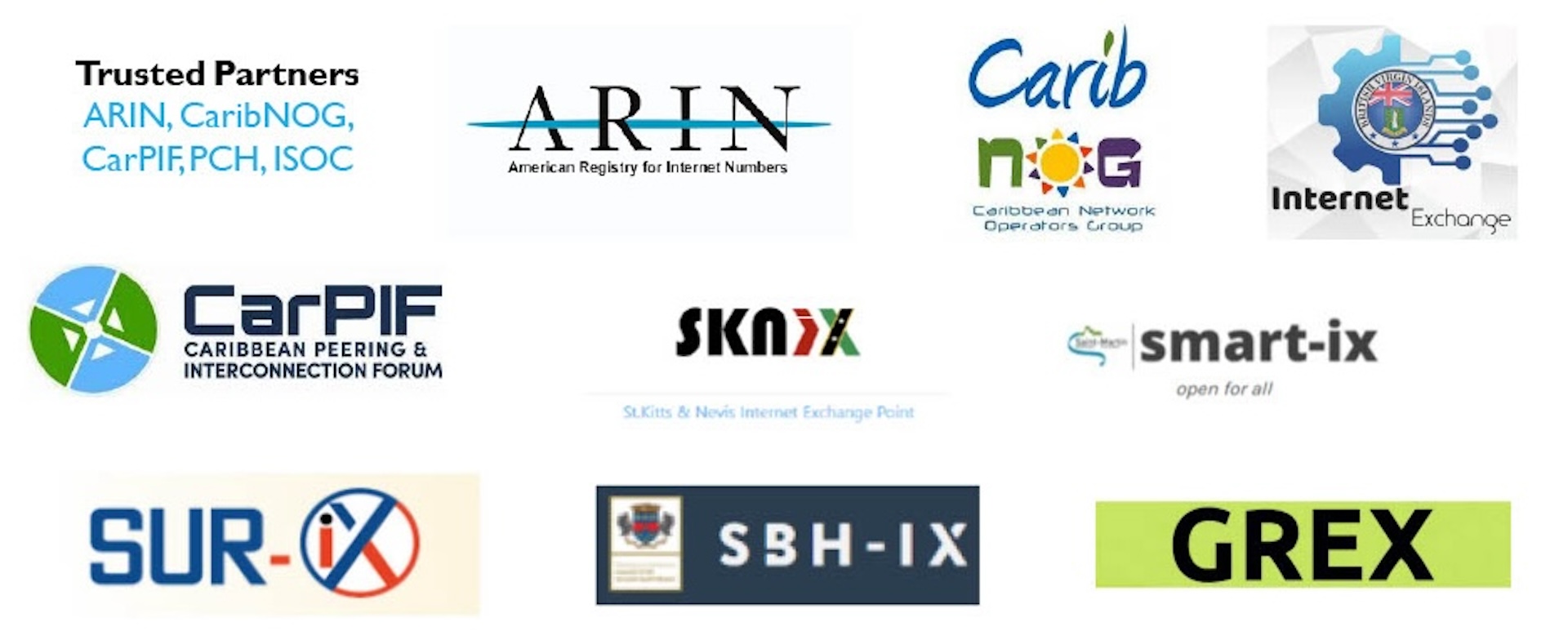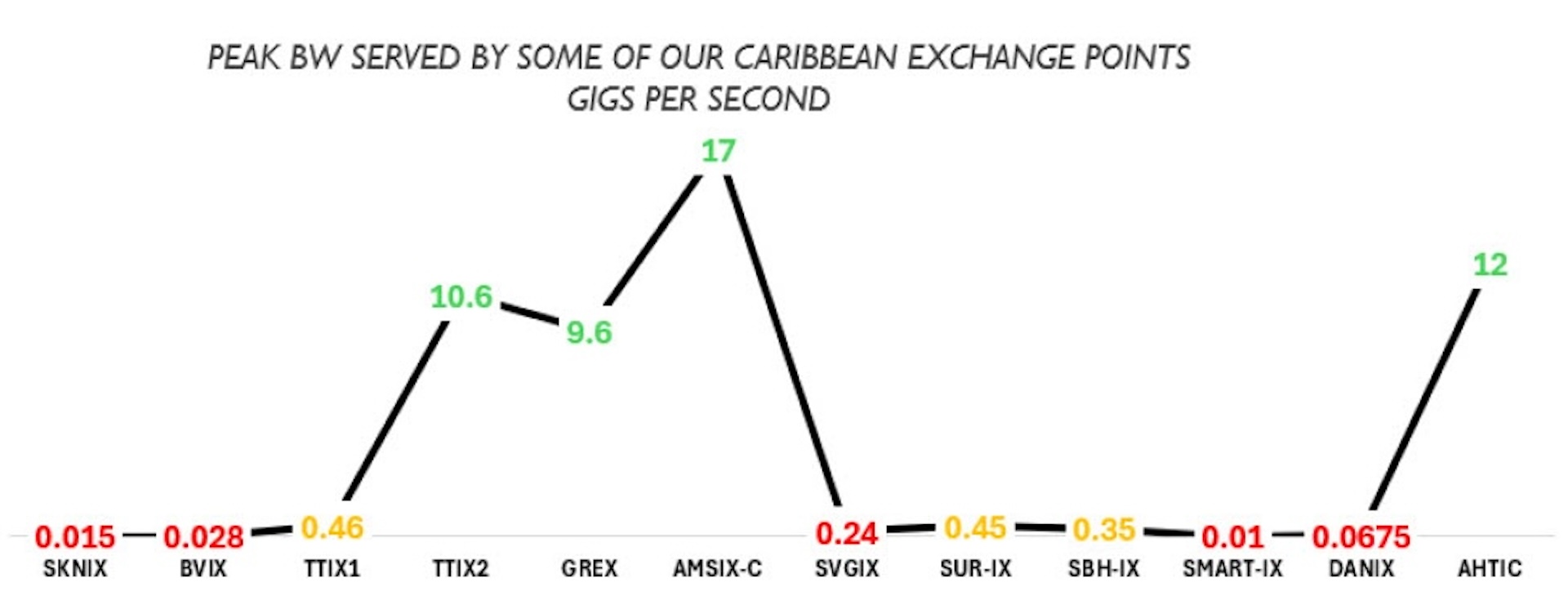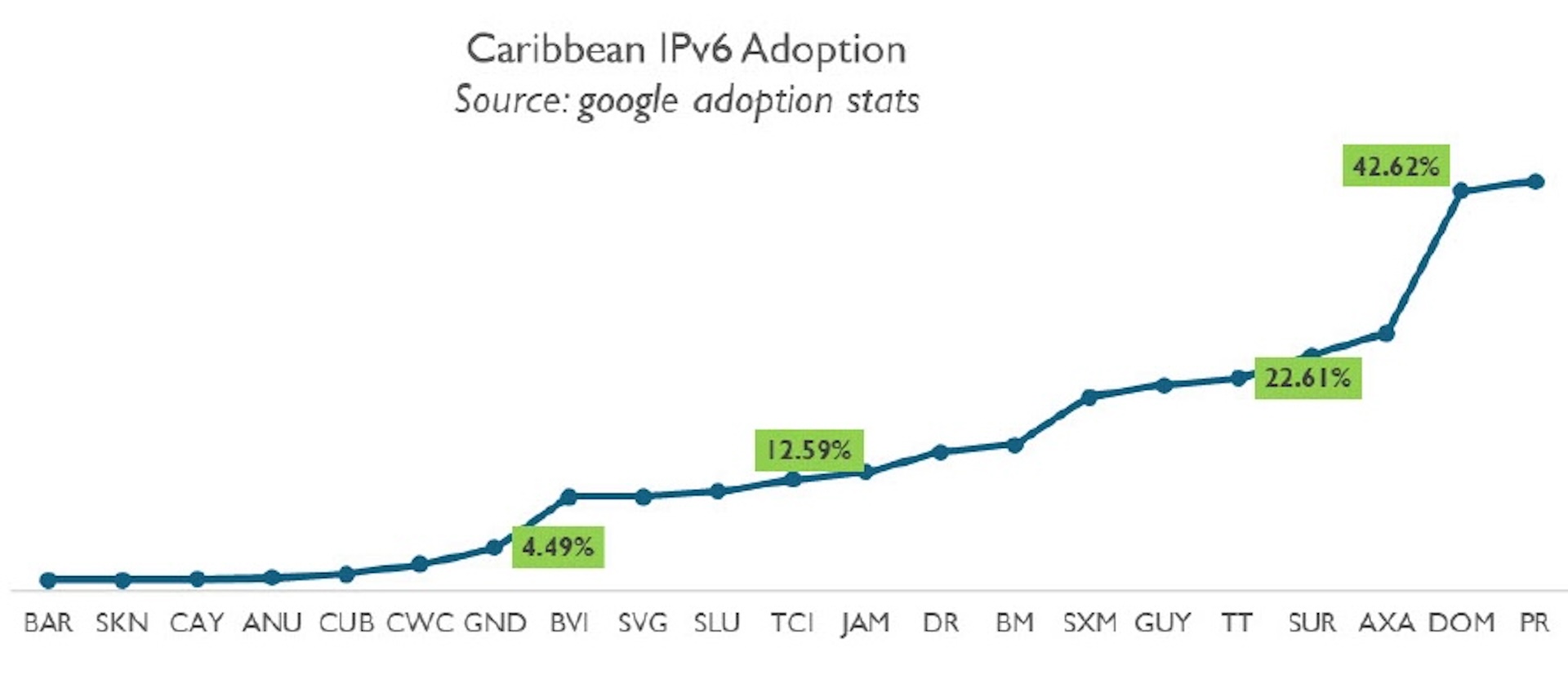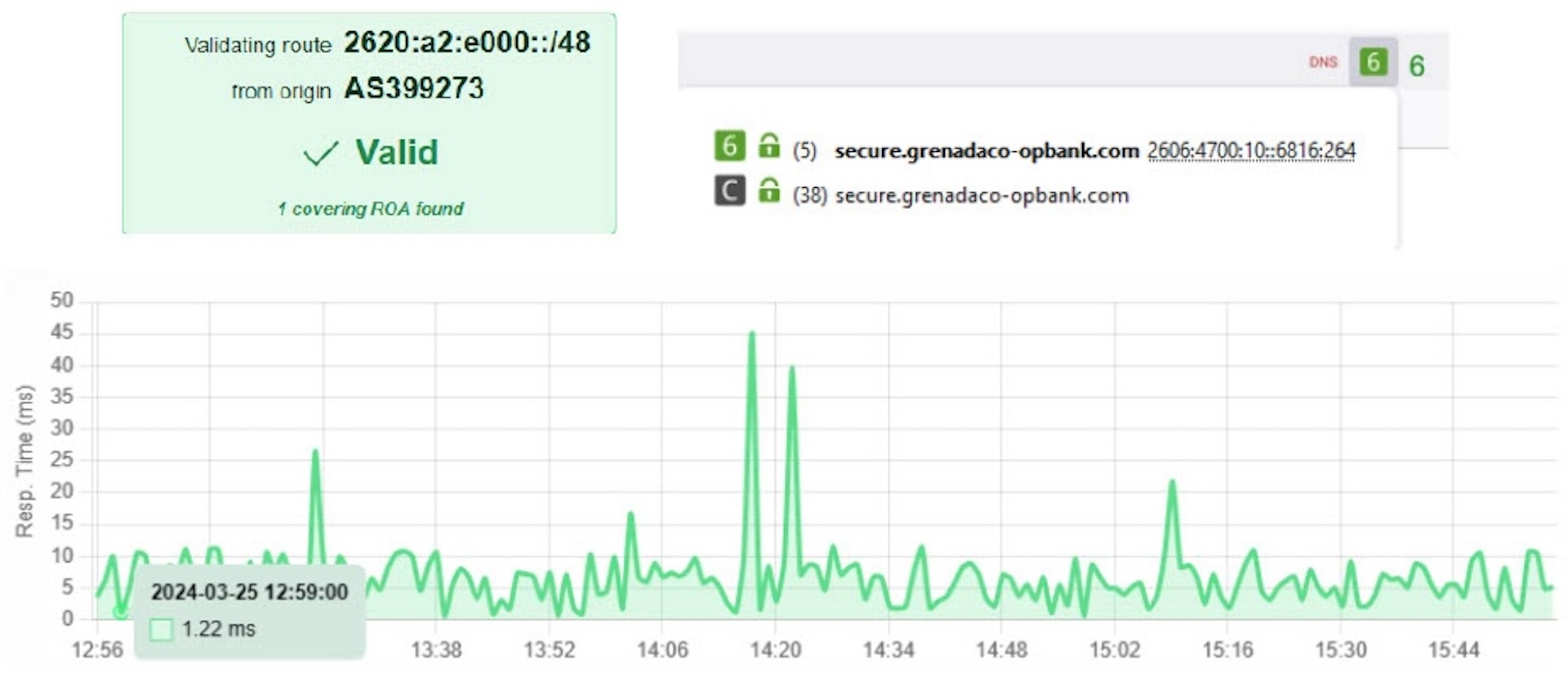
Building and Sustaining Caribbean Digital Infrastructure with IXPs and IPv6 Technologies
The ARIN 53 Public Policy and Members Meeting, held 14-17 April in Bridgetown, Barbados, and online, began with an insightful keynote address titled “Building and Sustaining Caribbean Digital Infrastructure with IXPs and IPv6 Technologies.” Delivered by Brent Mc Intosh, Chief Technology Officer for MCNET-SOLUTIONS, this presentation drew attention to the unique challenges and opportunities within the Caribbean region, shedding light on why and how it can build and sustain digital infrastructure with Internet exchange points (IXPs) and IPv6 technologies to promote economic success. Read on for a recap of this keynote and the critical considerations, stakeholders, case studies, and strategies discussed.
Watch the recording of Brent Mc Intosh’s keynote address on YouTube.
Emphasizing Local Digital Infrastructure
Brent began by posing a question: “The Caribbean has immense potential to boost its digital economy through technical innovation such as using next-generation Internet protocols and, of course, using connectivity based on critical infrastructure: How can we get to that position? And who can help us get there?” In response, he emphasized the importance of formulating strategies to continue building local critical infrastructure and fostering related supporting technology such as IPv6 with the help of partners like ARIN, CaribNOG, the Internet Society (ISOC), and more.

Brent then turned to the critical role of IXPs in improving the resilience and efficiency of the Internet across the Caribbean and supporting many Caribbean governments’ goals of increasing affordability and quality connectivity in local communities. “Enabling local networks to efficiently exchange data, that’s the whole point,” Brent said. “We just want to exchange data locally, not crossing international borders to get back into our local networks.” He noted that recent Caribbean IXP deployments are fully dual-stacked and ready to support the latest technologies once they’re able to start exchanging traffic. “They’re really deploying critical infrastructure to ensure that they can increase their economic value by providing seamless resident Internet connectivity locally.”
Status Check
Next, Brent addressed a few more questions: “Are Internet exchange points making a difference in the Caribbean? Is it worth the money? Is it worth the time? Absolutely. Will it work for every Caribbean island? Absolutely.” He followed up by suggesting that although not every Caribbean country is where it should be in terms of having a fully operational, efficient IXP, that will hopefully be a reality in the next five years.
“The thing is, they already have what it takes,” he said. “It’s now a social challenge of having stakeholders, parent parties actually connect and pair at those exchanges, exchange local traffic, and thereafter attract global and other content delivery networks. But that’s our job. Our job as Internet stakeholders — CaribNOG, ARIN, ISOC, yourselves — that’s where we make the difference.”

Sharing some statistics on the current state of IXP and IPv6 deployment in the Caribbean, Brent highlighted the peak bandwidths served by top-performing IXPs like TTIX2 (Trinidad), GREX (Grenada), AMS-IX (Curaçao), and AHTIC (Haiti), which range from 9.6 to 17 gigabits per second (gbps). He also reviewed IPv6 adoption rates, calling out Grenada’s increase from 0.14 percent in 2020 to more than 5.5 percent today as well as St. Vincent holding steady at over 12.5 percent, Trinidad and Tobago at 22.61 percent, and Dominica coming in at a remarkable 42.2 percent for reasons as yet unconfirmed.

Next Steps and Strategy
Having reviewed where things currently stand, Brent then began proposing a path forward with a particular emphasis on cybersecurity considerations. He drew upon the Cyber Defense Index used by the top 20 global economies as inspiration for focusing on building critical infrastructure, which is one of the four pillars of the Index.
“In the Caribbean we don’t have a cyber defense rating index. We’re small economies,” he said. “But that doesn’t mean that we can’t follow these strategies for having those pillars. We can start with our critical infrastructure.”
The next steps in building digital infrastructure Brent laid out were:
- DNS root server deployments for DNS security and improved DNS responses/resolutions,
- National data center services,
- Hosting global connected delivery networks (CDNs) to serve popular content from most-accessed domains like Google and Facebook locally from edge servers (e.g. Cloudflare, Apple, Akamai, Google),
- Local content hosting platforms to improve digital innovation and national digital growth index as Caribbean countries become producers and not just consumers of content, and
- Addressing cybersecurity challenges with DNSSEC and local DNS Anycast.
He was especially passionate about the need to build national data centers: “While I consider myself an evangelist for Internet exchange point deployments [and] Internet Protocol version 6 deployments, recently I’ve moved into the area of data center deployments because we’re seeing how all three, together, can make a huge difference to critical infrastructure.”
As for the strategy that would facilitate those next steps, Brent returned to multistakeholder engagement (with CaribNOG, the Caribbean Peering and Interconnection Forum, ARIN, Packet Clearing House [PCH], ISOC, and governments) as the main focus. He also called for the public and private sectors to agree upon agendas for cultivating tech savvy and digitally efficient workforces, reiterated the importance of a local content hosting platform to improve digital innovation and national digital growth index, and revisited the need to build the four pillars of the Cyber Defense Index.
Last but not least, Brent called for a champion of the cause. “To make all this happen, you need a champion,” he said. “A champion doesn’t mean one person doing it all. A champion means one person leading other champions, creating other champions, building a group of champions to take care of all the sectors that are required.”
Key Considerations and Offerings of IXPs
The presentation next explored why Caribbean IXPs can be instrumental in developing the local Internet ecosystem. Brent explained that they:
- Encourage development of local and regional communications infrastructure,
- Are not expensive to start,
- Build a community of technical experts,
- Attract a variety of global and local services,
- Incentivize the creation of local content and applications, and
- Facilitate value-added services (ex. Suriname Internet Exchange interconnecting into Amsterdam Internet Exchange to get more Dutch content into Suriname more efficiently).
Regarding the cost, he did note that this depends on what you want to achieve. “I’m proud to say that the Caribbean islands have taken the expensive route of building Internet exchange points with the best current operational standards and practices of global Internet exchanges,” he said. “It’s just that it’s at a smaller scale.”
Brent then pivoted from the why to the what, sharing a rundown of the services currently offered by Caribbean IXPs, nearly all of which are not-for-profit and some of which have government stakeholders involved. In general, those offerings are: local traffic exchange; a bilateral, non-mandatory selective peering policy; one to 10 gbps connectivity options; PCH DNS Anycast; and IPv4 support.
As for what Caribbean IXPs should and will offer in the future, Brent listed: a full suite of connectivity services including local cloud services interconnects, CDN peering, and regional DC cross-connects; a bilateral, nonmandatory open peering policy; 1 to 100 gbps and more connectivity options; global CDN hosting through regional partnerships; local DNS Anycast; and support for IPv4 and IPv6 by default.
Challenges for IPv6
Next, Brent addressed the differences seen between enterprise businesses and ISPs regarding IPv6 deployments, using statistics and examples from the meeting location (Barbados) and his own country (Grenada). While some ISPs in the region do IPv6 transit services, many hold IPv6 allocations but have not deployed IPv6 in transit and access networks.
“Barbados is special because it’s a very competitive telecom market. [It has] two strong telecom providers, both offering a wide range of, I think, quadpay services. And they both support the IPv6 protocol, more so on a transit level,” he said. “What’s the challenge? The main challenge is that while those providers can transit IPv6 through the networks and offer you maybe direct fiber connectivity, the broadband access networks have not been set up for Internet access deployment. Why is that? … Carrier-grade NAT is still being used around the Caribbean, all over the Caribbean.”
Brent explained that, when carrier-grade NAT (CGN) implementation started about five years ago, the expectation was that maybe in five years networks would be phasing away from it and moving into full IPv6. However, CGN is still being used and CGN hardware is being refreshed, which Brent pointed out is “pretty expensive stuff, both from a cap ex and op ex perspective.”
As for the question of enterprise versus ISP, he shared that enterprise businesses are now seeing the importance of IPv6, driven by global trends and the fact that public cloud services support IPv6-only virtual private clouds.
“Why in Grenada are we seeing an increase in IPv6 traffic?” Brent said. “Well, enterprise customers have decided that they are going to start doing some adoptions … [maybe] because it’s an efficient protocol, but maybe it’s just more effective for us from a business-case perspective because we have a lot of cloud services that are now offering things like BYOIP [bring your own IP]. … We have our IPv6 address space, then maybe we can do more because we intend to move away from a lot of on-prem services into cloud.”
Brent added that all the enterprise institutions in Caribbean that he sees moving to IPv6 fall into the financial sector, which means they’re thinking a little different and perhaps seeing something that the ISPs are not. “But whatever they’re seeing,” he said, “it’s important to them.”
Case Studies
ISP Benefits: An IPv6 Use Case
Moving on from the challenges to examples of success, Brent shared a few case studies of IPv6 and IXP deployments in the Caribbean. First, he explored the benefits of IPv6 for an ISP with a look at Cable Bahamas, which is the first Caribbean ISP to deploy dual-stack from “core to door.”
“They have deployed IPv6 in their core, and they’re delivering this to their fiber to the home customers,” Brent said. “And they followed a [best-practice] model that made sense. They first invested in training and, through that, trained their staff. Then they moved towards deployment planning. And then from that stage they decided, hey, we’re going to go into implementation, and, of course, there’s no deployment without issues. So we’re going to have our optimization phase after.”
Now, following a seamless transition during which no customers questioned or complained about their IP configuration, Cable Bahamas benefits from being able to offer customers connectivity to locally hosted CDNs as well as secure e-services with low latency access. Brent measured the IPv4 to IPv6 traffic ratio in his own home and confirmed that 45 to 50 percent of content is accessed over IPv6.
Enterprise Benefits: An IXP and IPv6 Use Case
For an enterprise case study, Brent featured Grenada Co-op Bank, one of the country’s largest banks and its first financial entity to peer on the Grenada Internet exchange and the first to deploy IPv6. Why did they take the leap? Because their secure e-services are hosted with a very popular CDN that happens to be hosted in the local Internet exchange.
Brent explained the logic behind their transition: “If my end users can grab my e-services really, really quickly and efficiently, then that makes sense for me. So that was a no-brainer, and the rest is history.” The rest includes deciding to also start using other services like ARIN’s Hosted Resource Public Key Infrastructure and DDoS protection for their BGP. “They spared no expense in ensuring they had a resilient secure infrastructure for all their edge services,” Brent said. “Dual-parent points, dual-parent routers, multiple ISPs, both dual-stack. The only thing to test now is literally shutting down one side and make sure the failover is seamless.”
Brent shared a chart of the low average latency with which Grenada Co-op Bank’s e-services are accessed along with confirmation of IPv6 support and Route Origin Authorization coverage for their routes.

The main point, Brent emphasized, is that because their customers mean so much to them, the bank put an infrastructure in place — supported by local Internet exchanges, local content service, and local DNS — to ensure that their services would always be available to end users. The economic benefit for the bank is that a significant portion — 33 percent — of their e-commerce traffic goes local (which means efficiency and reliability), and the expectation is that that will grow over the next few years.
Government Benefits: An IXP Use Case
Last but not least, Brent provided an IXP case study from the government sector. Calling attention to governments’ uniquely large workforces that access popular social media and streaming content and deliver e-services, he shared how the government of Grenada decided to request their own ASN, IPv4, and IPv6 resources from ARIN and become the first government entity in the region to peer on the local Internet exchange. This has allowed them to offload some of their traffic locally (67 percent of social media and streaming content), save money on transit services, and ensure that staff get low-latency, high-quality access to the content they need to serve residents.
Moving Forward
Before closing out his presentation with a reminder of the need to work with partners like ARIN and have participation from the Caribbean technical community (i.e. CaribNOG, CarPIF) to achieve continued growth of IPv6 and IXPs in the region, Brent highlighted the rise of local supporting companies like Calatech, Kapasiti, and MCNET-SOLUTIONS.
In a final thought, Brent encouraged community members to stay engaged with opportunities to learn current best practices, like the ARIN Public Policy and Members Meetings. “It’s important to try to follow the industry standards and trends,” he said. “And that is where these meetings make the difference; the people you need to speak to are right in this room. Trust me.”
Questions from the Community
Following his presentation, Brent fielded a few questions from meeting participants. They covered topics from IPv4 resource allocations and how natural disaster recoveries impact IPv6 and IXP deployment to what can be done to support IXP progress in the French West Indies.
For the full content of Brent Mc Intosh’s presentation, including the Q&A portion of the session, read the transcript of the keynote address.
Brent Mc Intosh’s keynote address at ARIN 53 was not only a reflection on the current state of the Caribbean’s digital infrastructure and a roadmap for its future, but it also served as a call to action for all those invested in the Caribbean’s digital progress, highlighting the benefits of embracing IXPs and IPv6 technologies. It served as a reminder of the region’s potential, and the collective effort required to unlock it.
Learn about ARIN’s activity in the Caribbean and find resources on digital progress, IPv6, and industry events in the region at arin.net/caribbean.
Recent blogs categorized under: Public Policy
GET THE LATEST!
Sign up to receive the latest news about ARIN and the most pressing issues facing the Internet community.
SIGN ME UP →Blog Categories
ARIN Bits • Tips • Updates • Elections • Caribbean • Outreach • Security • RPKI • Public Policy • Guest Post • Grant Program • Fellowship Program • Data Accuracy • IPv6 • Business Case for IPv6 • Internet Governance • Training • IPv4 • Customer Feedback • IRR


